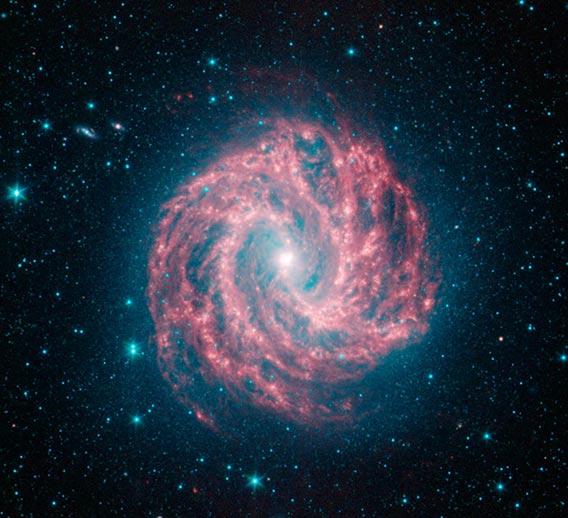Create a free profile to get unlimited access to exclusive videos, sweepstakes, and more!
Blowing the Dust Off a Spiral Galaxy

I was digging around the web looking for some info and stumbled on something that really surprised me: a picture of an old friend I had never seen before!
Of course, Iâm an astronomer, so when I say âold friendâ I mean some gorgeous astronomical object. In this case, itâs the spectacular face-on spiral galaxy M83, also called the Southern Pinwheel, for obvious reasons:
Isnât that breathtaking? This image was taken by the space-based Spitzer Space Telescope, which sees the Universe in infrared light, outside the range our eyes can detect. It uses filters to distinguish various wavelengths (colors) of IR light, and then astronomers turn them into images we can see by assigning a visible light color to each wavelength. In this case, what you see as blue is actually light at 3.6 microns (a wavelength about 5 times longer than what your eye can see), green is 4.5 microns, and red is 8 microns.
For the most part, warm objects emit light at these wavelengths. But to an astronomer, -170 Celsius (-270 Fahrenheit) is warm! Donât ask us what âcoldâ is.
In a galaxy, strewn between the stars, are vast clouds and ribbons of complex molecules called polycyclic aromatic hydrocarbons, or PAHs for short. We also just call it âdustâ. This stuff is essentially soot, and itâs created when stars are born, and when they die. Regions where galaxies furiously make stars are littered with this dust, and it warms up due to the nearby stars. It then glows in infrared, and can be seen by Spitzer to make the above picture.
M83âs lovely spiral arms are where all those stellar nurseries are, so we see them festooned with the cotton-candy-like dust emitting infrared light. The picture looks similar, but different, in visible light. Hereâs a shot using the European Southern Observatoryâs MPG/ESO 2.2-meter Telescope:
The spiral arms are still there, but now you can see the pink glow of gas clouds, and the blue of hot, young, massive stars blasting light into space. Stars give off infrared light too, so you can see some of the same ones in both images (those stars, Iâll note, are in the foreground, in our own Milky Way). I rotated the image to match that of Spitzer so you can compare them. As gorgeous as this is, I think my favorite part of this picture is the two nearly edge-on spiral galaxies in the upper left. M83 is about 15 million light years away, but those two guys are much more distant, hundreds of millions of light years away at least.
And one other thing: take a look again at the Spitzer image. It looks a bit off-center, doesnât it? Too low? When I cropped the image I thought I had messed it up, but in fact the center of the galaxy is centered in the image. Measure it yourself! It turns out the galaxy itself is a bit lopsided, asymmetric. The bottom half stretches out farther than the top, both in the infrared and visible light images. Thatâs interesting! Not all galaxies are perfectly symmetric; a nearby galaxy passing by can distort them, for instance.
However, nothing like that is near enough to M83 to have done this. I did a quick journal search, and discovered that M83 almost certainly recently ate a smaller galaxy. I donât know if this is enough to explain the asymmetry, but itâs interesting. Iâll note that thereâs a vast cloud of hydrogen surrounding the galaxy (thatâs fairly common), but it too is off-center, and in the same direction the galaxy itself is. Recent observations indicate M83 has (at least) a double nucleus, which is what you get when youâre still digesting a smaller galaxy. This can also trigger star formation, which is definitely the case for M83. I also dug up a reference to a huge arc of material obviously associated with the galaxy, but with unclear origins. I have no clue if that has anything to do with this or not.
So Iâm thinking something happened to M83 to knock it around. A collision and eventual merger with another galaxy would explain it, but who knows?
And thatâs the best part, isnât it? I donât know what the answer is, and Iâm not convinced Iâve seen anything in the literature explaining it either (in fact, I saw several references to M83 being remarkably symmetric, an observation with which I now donât agree).
Funny. I intended this to be a short post just describing a fun galaxy I happened upon⦠and now look! Everything I wondered about led me to another interesting path, which I merrily walked down. Now I know a lot more about M83 than I did before... and in some ways maybe less, because now I have even more questions. Which is awesome.
Science! I love this stuff.


























